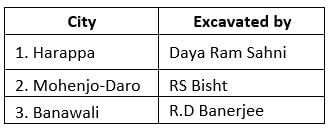Test: Introduction Of IVC & Town Planning - UPSC MCQ
20 Questions MCQ Test - Test: Introduction Of IVC & Town Planning
Consider the following pairs:

Which of the pairs given above is are correct?

Consider the following statements regarding Indus Valley Civilisation
1. It is a bronze age civilization.
2. It flourished around 3500 BC.
3. The script of it is not deciphered.
Which of the statements given above is/are correct?
2. It flourished around 3500 BC.
3. The script of it is not deciphered.
| 1 Crore+ students have signed up on EduRev. Have you? Download the App |
Which of the following sites is/are part of the Mature Harappan phase?
1. Mehergarh
2. Harappa
3. Mohenjo-daro
4. Lothal
Select the correct answer using the codes given below:
2. Harappa
3. Mohenjo-daro
4. Lothal
Who of the following proposed Sumerian origin theory regarding Indus Valley Civilization?
Consider the following statements regarding proto-dravidian origin theory of Indus Valley Civilization.
1. A lot of the IVC artefacts resemble the traditional artworks excavated from South India.
2. There is some similarity between the IVC script and the Brahmi Script.
Which of the statements given above is/ are correct?
Consider the following:
1. Granaries
2. Pillared halls
3. Courtyards
4. Burnt bricks
Which of the above is/are characteristics of Indus Valley Civilization architecture?
Which of the following statement is not correct regarding Indus Valley Civilization?
Consider the following statements:
1. The Indus bricks were of standard in size
2. The house planning is well evident from the lower town of the Mohenjo-Daro.
Which of the statements given above is/are incorrect?
Concerning Town planning of Indus valley civilization, consider the following statements:
1. Granaries were found only in Harappa and Mohen-jo-Daro sites.
2. Two rows of six granaries were found at Harappa.
Which of the statements given above is/are correct?
Which of the following statement is not correct regarding the Great Bath?
Which of the following has a platform inside the citadel with fire-altars on top of it?
1. Kalibangan
2. Banwali
3. Harappa
4. Chanhudaro
5. Lothal
6. Mohenjo-daro
Which of the statements given above is/are correct?
The evidence of Indian ships and a piece of woven cloth has been discovered from the seals of which of the following sites?
Until recently the main evidence for fixing the date of the Indus Valley Civilization was the seals found in West Asia in levels ascribable to the reign of Sargon of Akkad and its date was fixed at 2500-1500 B.C. But which method is the latest in fixing the date of Indus Valley Civilization?
A scale has been found at which of the Harappan sites?
The Harappan houses opened on the main street in which one of the following cities?
Which of the following statements on the Harappan civilization is wrong?
This archaeological site consist of a number of low archaeological mounds created by generations of superimposed mud brick structures. Located close to the mouth of the Bolan Pass, it was abandoned by the time of the emergence of the literate urbanised phase of the Indus Civilisation. An entry in the UNESCO tentative list, it is?


















